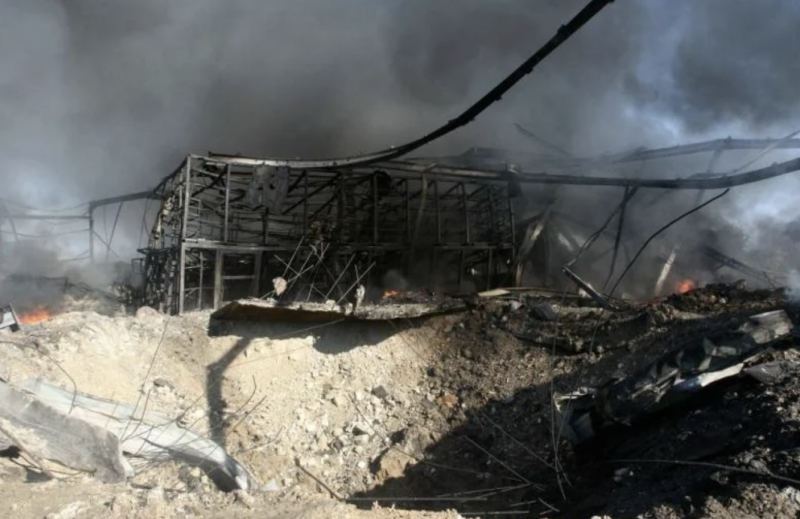
Damage caused by Israeli strikes on Monday, Feb. 19, 2024 on Ghazieh, south Lebanon. (Credit: Mahmoud Zayyat/AFP)
Every time Israel targets a new site deeper in Lebanese territory, it raises a question: Is this an escalation signaling a potential expansion of the southern Lebanon front, which is meant to be confined to south of the Litani River?
This question becomes more urgent following Monday’s airstrikes on the town of Ghazieh, near Saida, 50 kilometers from the border with Israel, which left 14 people injured.
If the Israeli army’s claims of targeting “Hezbollah arms depots” are confirmed, this latest raid might be viewed as a pinpoint strike, akin to political assassinations, rather than a widening of the scope of operations.
Notably, Israel previously struck the heart of the southern suburbs of Beirut, assassinating Hamas’s number two, Saleh al-Arouri, on Jan.2. Despite being labeled “provocative,” this attack didn’t alter the scale or nature of the ongoing war.
Testimonies from Ghazieh residents indicate that the strikes targeted an industrial zone on the town’s outskirts, which housed warehouses storing barrels of oil, fuel oil tanks for generators and another shed with scrap metal and tires.
Residents have dismissed the possibility of weapons being stored there.
When contacted, Hezbollah did not respond.
While the recent operation may appear to exceed the typical rules of engagement between Hezbollah and Israel, several analysts argue against interpreting it as a precursor to broader conflict.
They suggest that it’s more about Israel applying additional pressure on its adversary, as Hezbollah is keen to avoid war if possible.
“As long as Hezbollah, Iran and the United States signal their reluctance for a full-scale war, Israel feels emboldened to strike as it sees fit,” said Michael Young, a researcher at the Carnegie Near East Centre. “Israel is seizing upon this advantageous situation.”
Raising the ire of the population
This latest operation is evidently aimed at exacting a heavy toll on the Lebanese populace at large, particularly the Shiite community, to stoke resentment against Hezbollah.
The targeted area, an industrial hub, has incurred significant losses, with private hangars bearing the brunt of the destruction.
“We’re talking about millions of dollars lost, especially with the destruction of numerous generators on the premises,” shared a resident of Ghazieh, requesting anonymity.
The narrative propagated by Israel regarding the presence of arms caches is likely to further sway a population not always aligned with Hezbollah’s cause, particularly emphasizing Lebanon’s perceived accountability for the “support for Gaza.”
The notion of an underground arms depot situated in sheds near residential areas is inherently provocative and likely to enrage local residents.
“Israel aims to stoke a popular uprising against Hezbollah by evoking memories of the 2006 war,” said Faysal Abdel Sater, an analyst with close ties to Hezbollah.
During that period, Israeli planes dropped leaflets urging Lebanese citizens to revolt against Hezbollah.
In the same vein, the Israeli army is seeking today to convey a message that it is capable of hitting any Shiite area, regardless of proximity to the border, or even locations elsewhere in the country, as Israeli officials have repeatedly warned.
“Israel maintains a substantial bank of potential targets,” said Bassam Yassine, a retired army officer with extensive service in southern Lebanon. “It’s a matter of timing and strategy. Whenever there’s an opportunity to strike, it [Israel] will seize it.”
Hassan Qotob, a researcher from Saida, suggests that if there is any symbolism behind the strikes, it lies in the proximity of Ain al-Hilweh, the largest Palestinian refugee camp, to the target location in Ghazieh. According to him, this could be interpreted as a thinly veiled threat to both Hezbollah and Palestinian Hamas, indicating that “the next stage could well be the refugee camps.”
Another explanation for the timing and scale of the strike can be found, once again, in the ongoing diplomatic negotiations aimed at achieving a lasting settlement. Like other observers, Young believes that the recent acts of belligerence are part of Israel’s attempt to influence the outcome of the negotiations.
Psychological warfare
Even though both Israeli Prime Minister Benjamin Netanyahu and Hezbollah leader Hassan Nasrallah have recently hinted at escalating tensions — threats that must be interpreted within the context of psychological warfare — ceasefire negotiations persist.
Efforts are underway to “keep the conflict in southern Lebanon at the lowest level possible,” as put by US envoy for Lebanon Amos Hochstein during the Munich security conference on Saturday.
“Benjamin Netanyahu is primarily focused on his political survival,” Young said. “Therefore, it’s in his interest to prolong the deadlines as much as possible.”
The researcher dismissed the possibility of future escalation, at least one that may lead to full-scale war.
Ultimately, such a scenario is undesirable for all parties involved, including Israel, which seeks to avoid upsetting its principal financial supporter and arms provider, the US.
The forthcoming response from Hezbollah remains to be seen, as the group has vowed to retaliate whenever Israel strikes.
“This time, it will be about targeting facilities in response to targeted facilities, and striking factories in response to targeted factories,” said Abdel Sater.
This article was originally published in L'Orient-Le Jour. Translated by Sahar Ghoussoub.